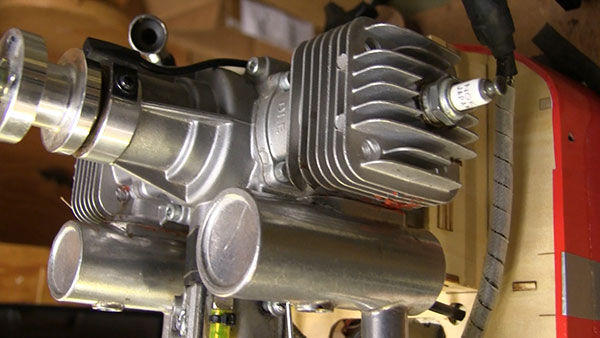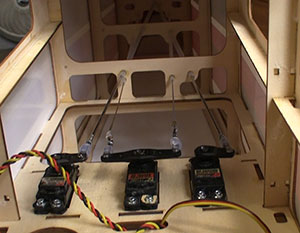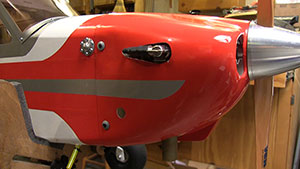



From what I had seen of the Valiant I knew I wanted good horsepower so I
installed my DLE 40-Twin. A great motor that I am trying to fly to death.
Text, photos and Video by Tom Hintz
Posted – 9-12-2016
The Hangar 9 Valiant 30cc features servo-ready openings complete with laser-cut pilot holes for the screws that secure my HiTec HS-5565MH servos in place. There is a place in the interior for the throttle servo but I opted to put that in the bay under the fuel tank because it is more easily accessed and being much closer to the engine means a shorter more rigid linkage. I like using shorter throttle linkages, particularly one made from carbon fiber tubing fitted with titanium threaded inserts like the one I used here. These rods are exceptionally tough, very lightweight and do not flex.
I am a big fan of redundant batteries and redundant satellite receivers to protect my big planes. For the Hangar 9 Valiant 30cc I went with the Spektrum AR9110 9-Channel DSMX PowerSafe Receiver. This receiver has dual battery plugs (I converted to Deans connectors) and is supplied with three satellite receivers each on a different length cable to make a diverse signal plane installation easier. Take your time with this installation and radio interference is closing in on impossible. I also used the Spektrum “soft switch” that was designed specifically for the Powersafe receivers. The switch is designed so that it can only fail into the On position.
To provide electrical power to the Hangar 9 Valiant 30cc I am again using a pair of my favorite Glacier 7.4V, 5000mAh LiPo packs. Yes, they may be overkill for most people but I tend to fly a bunch when things are right and this kind of battery capacity keeps my planes safely powered all day. I am writing this after the maiden weekend and just on Memorial Day I put in 9 flights. The 5000mAh packs showed 86% capacity remaining, my kind of safety cushion.

I like the "no fooling around" linkages.
Note: For this review I followed the instruction manual closely and used the settings listed. In the manual they say that the control throws listed are to be a starting point and that after getting used to the Hangar 9 Valiant 30cc you may want to increase them. This is a very good plan, especially for someone not familiar with this kind of plane. I will be doing a separate segment of the Hangar 9 Valiant 30cc build showing what happens when we increase control throws and maybe even tweak the CG some to extract even more “responsiveness” from the Hangar 9 Valiant 30cc.
The Hangar 9 Valiant 30cc comes with solid steel 4-40 linkages fitted with steel clevises. All of the hardware looks to be more than sufficient for the job. The manual also gives very specific lengths for the servo control arms on the ailerons and flaps to maintain the intended geometry. This is an important point because of the unusually aerobatic capabilities of the Hangar 9 Valiant 30cc. Control throws are going to be important during setup so we need to get these parts right during the build.
I used the high strength servo arms provided with most HiTec servos. I had to measure out from the center bolt hole to control locating hole dimensions listed in the manual and trim the unused portion of the servo arms off to avoid conflicts. The 4-40 clevises fit the servo arm holes tightly so I found a drill that was slightly bigger than the existing holes and opened them to insure a free but slop-free fit.
The rudder has dual control horns that accepts the steel cable pull-pull system that also uses 4-40 steel clevises. The Hangar 9 Valiant 30cc has factory-installed tubes that guide the elevator control rods and the rudder pull-pull cables from the servos to the tail control surfaces making this part of the build way easier than it could be.
Overall the control linkages are more than adequate but I would like to see turnbuckles on the ailerons, flaps and elevators to make dialing the Hangar 9 Valiant 30cc in perfectly easier. Turnbuckles are becoming commonplace on all types of RC models and that needs to spread to even more of them.

The interior is large with lots of options for
mounting all the stuff that makes an RC
plane fly.
The Hangar 9 Valiant 30cc has an interesting option in landing gear. You can use the stout formed aluminum gear normally provided with this plane or as an extra cost option Hangar 9s’ ¼-scale Cub articulated gear can be bolted up without having to modify the Hangar 9 Valiant 30cc! The additional mounting blind nuts for the Cub style gear have been installed at the factory but hidden by the covering. These extra mounting points can be used to install the Hangar 9 ¼-1/4-scale float kit if flying off of water is of interest.
The Hangar 9 Valiant 30cc comes with 3-1/2” diameter wheels/tires that fit the included fiberglass wheel pants. For those of us who want to explore the STOL (short takeoff and landing) capabilities of the Hangar 9 Valiant 30cc adding a bigger tire and wheel set is sort of mandatory. I chose the 6” tall DuBro inflatable “Big Wheels” (#600RV). Using these wheels means having to add 2”-long DuBro axles as well but that is an easy bolt-on change as is installing the “Big Wheels”. With the wheels being so much bigger there is somewhat of a weight penalty but the Hangar 9 Valiant 30cc flight envelope is sufficiently large that it doesn’t seem to care much about the extra wheel weight.
One of the nice surprises during this build was the factory-installed 10/32 blind nuts intended for mounting the suggested 33cc Evolution Engine. It turns out that they also fit the DLE40 Twin mounting pattern perfectly. I did have to figure out the needed firewall to prop washer dimension (152mm for me) so the prop and spinner would clear the front edge of the cowl with a small gap between them. To reach this dimension I had to use 16mm standoffs behind the stock DLE40 Twin mounting plate. For this installation I used 1-1/2”-long 10/32 socket head bolts with split and flat washers under each bolt head.
The other pleasant surprise was that the DLE40 Twin fits within the Hangar 9 Valiant 30cc cowl with only the spark plugs and their cable caps protruding. The offset of the motor puts the cylinder fins on the (pilots) left side over ¼” from the cowl for good cooling and no vibration/rubbing damage to the cowl or engine. We have been flying the Hangar 9 Valiant 30cc in 90+degree weather with cylinder temperatures under 180-degrees on landing. Not bad at all.

The cowl cut nicely to fit around the DLE
engine. It matches the fuse colors
perfectly.
Bill R of the FlyingRC.net “Texas Bill Squad” ordered the Hangar 9 Valiant 30cc electric power conversion kit specifically for the battery tray that is included. He discovered that this tray works great for putting the gas tank on. The tray slides into the cavity under the dash and is secured with a finger bolt in the cabin area of the fuse. High wing planes of this size tend to have the fuel tank located “under the dash” and that can be a little problematic in terms of access and installation. The battery tray makes installing the tank way easier and has proven to be another good idea from Bill R and the FlyingRC.net Texas Bill Squad!
I used a RotoFlow 16oz tank which fit on the tray and in the dash cavity nicely. I did have to fish the fuel tubing through to bring the lines out of the fuselage but that was not a big deal especially considering how clean the installation is in the cabin area. The line to the carb is shielded with the armor wrap that comes with ignition systems and an in line fuel filter was added just before the carb inlet.
With all of the DLE40 Twin components in place I could cut the cowl to fit. There is a full story on my “system” for cutting cowls in the How-To’s section of FlyingRC.net. The important thing about this cowl and engine is that both cylinders fit within the cowl with just the spark plugs and their plug wire caps protruding through the cowl sides. The Hangar 9 Valiant 30cc cowl is larger toward the front and sweeps back to the fuse after where the cylinders are, contributing to the nice fit around the engine.
The exhaust and choke handle stick out the bottom of the cowl but do not dominate the look of the rather sleek Hangar 9 Valiant 30cc cowl. I left the frontal openings as they came out of the box and did not open any other forward-facing surfaces. The carb is a good distance from the bottom of the cowl so air flow is not impeded. At this writing I have put in two solid days of flying the Hangar 9 Valiant 30cc and the engine is performing perfectly and temperatures are staying well in the normal range. The DLE40 Twin and Hangar 9 Valiant 30cc make a great pair as you will see in the upcoming Maiden and flying segments of this review series. At this point there is a separate segment of the Hangar 9 Valiant 30cc planned to look at increasing control throws and perhaps moving the CG to help increase control performance over all. Stay tuned for more on that process later in this series.
Hangar 9 Valiant 30cc Segment 1 – Click Here
Visit the Hangar 9 Valiant 30cc web page – Click Here
Have a comment on this Review? –Email Me!